Zircon, Monazite SHRIMP U-Th-Pb and Quartz Oxygen Isotopic Results from the Higher Himalayan Crystallines (HHC) of the Sikkim Himalayas
Abstract
:1. Introduction
2. Geological Framework
3. Analytical Techniques
4. Internal Structure of Zircon and Monazite
4.1. North Sikkim 19-005
4.2. North Sikkim 19-006
4.3. North Sikkim 19-009
4.4. West Sikkim 19-010
5. Results of the Zircon Dating
5.1. Protolith
5.1.1. North Sikkim 19-005
5.1.2. North Sikkim 19-006
5.1.3. North Sikkim 19-009
5.1.4. West Sikkim 19-010
5.2. Igneous Ages
5.3. Metamorphic Ages
5.3.1. North Sikkim 19-005
5.3.2. North Sikkim 19-009
5.3.3. West Sikkim 19-010
6. Results of the Monazite Dating
6.1. North Sikkim 19-005
6.2. North Sikkim 19-006
6.3. North Sikkim 19-009
6.4. West Sikkim 19-010
7. Results of the Oxygen Analyses
7.1. Zircon
7.1.1. North Sikkim 19-005
7.1.2. North Sikkim 19-006
7.1.3. North Sikkim 19-009
7.1.4. West Sikkim 19-010
7.2. Monazite
7.2.1. North Sikkim 19-005
7.2.2. North Sikkim 19-006
7.2.3. North Sikkim 19-009
7.2.4. West Sikkim 19-010
7.3. Quartz
7.3.1. North Sikkim 19-005
7.3.2. North Sikkim 19-006
7.3.3. North Sikkim 19-009
7.3.4. West Sikkim 19-010
8. Discussion
9. Conclusions
Supplementary Materials
Author Contributions
Funding
Data Availability Statement
Acknowledgments
Conflicts of Interest
References
- Leech, M.L.; Singh, S.; Jain, A.K.; Klemperer, S.L.; Manickavasagam, R.M. The onset of India-Asia continental collision: Early, steep subduction required by the timing of UHP metamorphism in the western Himalaya. Earth Planet. Sci. Lett. 2005, 234, 83–97. [Google Scholar] [CrossRef]
- Leech, M.L.; Singh, S.; Jain, A.K. Continuous Metamorphic Zircon Growth and Interpretation of U-Pb SHRIMP Dating: An Example from the Western Himalaya. Int. Geol. Rev. 2007, 49, 313–328. [Google Scholar] [CrossRef]
- Parsons, A.J.; Hosseini, K.; Palin, R.M.; Sigloch, K. Geological, geophysical and plate kinematic constraints for models of the India-Asia collision and the post-Triassic central Tethys oceans. Earth Sci. Rev. 2020, 208, 103084. [Google Scholar] [CrossRef]
- Singh, S.; Barley, M.E.; Jain, A.K. Tale of two migmatites and leucogranite generation within the Himalayan Collisional Zone: Evidences from SHRIMP U-Pb zircon ages from Higher Himalayan Metamorphic Belt and Trans-Himalayan Karakoram Metamorphic Belt, India. Himal. J. Sci. 2004, 2, 251–252. [Google Scholar] [CrossRef]
- Le Fort, P. Metamorphism and magmatism during the Himalayan Collision. In Collision Tectonics; Coward, M.P., Ries, A., Eds.; Special Publication; Geological Society: London, UK, 1986; Volume 19, pp. 159–172. [Google Scholar]
- Kohn, M.J. Himalayan metamorphism and its tectonic implications. Annu. Rev. Earth Planet. Sci. 2014, 42, 381–419. [Google Scholar] [CrossRef]
- Jain, A.K.; Singh, S.; Manickavasagam, R.M. Himalayan Collision Tectonics. Gondwana Res. Group Mem. 2002, 7, 114. [Google Scholar]
- Jain, A.K.; Manickavasagam, R.M. Inverted metamorphism in the intracontinental ductile shear zone during Himalayan collision tectonics. Geology 1993, 21, 407–410. [Google Scholar] [CrossRef]
- Yin, A. Cenozoic tectonic evolution of the Himalayan orogen as constrained by along-strike variation of structural geometry, exhumation history, and foreland sedimentation. Earth-Sci. Rev. 2006, 76, 1–131. [Google Scholar] [CrossRef]
- Goscombe, B.; Gray, D.; Foster, D.A. Metamorphic response to collision in the Central Himalayan Orogen. Gondwana Res. 2018, 57, 191–265. [Google Scholar] [CrossRef]
- Singh, S. Collision Tectonics: Metamorphic and Geochronological Constraints from Parts of Himachal Pradesh, NW-Himalaya. Ph.D. Thesis, University of Roorkee, Roorkee, India, 1993. [Google Scholar]
- Singh, S.; Jain, A.K. Deformation and strain pattern in parts of the Jutogh Nappe along the Sutlej valley in Jeori-Wangtu region, Himachal Pradesh, India. J. Himal. Geol. 1993, 4, 41–55. [Google Scholar]
- Singh, S.; Jain, A.K. Himalayan Granitoids. J. Virtual Explor. 2003, 11, 1–20. [Google Scholar] [CrossRef]
- Searle, M.P.; Cottle, J.M.; Streule, M.J.; Waters, D.J. Crustal melt granites and migmatites along the Himalaya: Melt source, segregation, transport and granite emplacement mechanisms. Earth Environ. Sci. Trans. R. Soc. Edinb. 2009, 100, 219–233. [Google Scholar] [CrossRef]
- Singh, S. Himalayan magmatism through space and time. Episodes 2020, 43, 358–368. [Google Scholar] [CrossRef]
- Singh, S.; Rit, B.; Prabha Mohan, S.; Kushwaha, A. Crustal melting evidence in migmatites of Higher Himalayan Crystallines (HHC) along Bhagirathi, Dhauliganga valleys, and Sikkim Himalayas, India. J. Geol. Soc. India 2022, 98, 69–73. [Google Scholar] [CrossRef]
- Singh, S.; Kushwaha, A. Melt Enhanced Deformation in Migmatites of Higher Himalayan Crystallines (HHC), India. J. Geol. Soc. India 2023, 99, 9–12. [Google Scholar] [CrossRef]
- Najman, Y.M.R.; Pringle, M.S.; Johnson, M.R.W.; Robertson, A.H.F.; Wijbrans, J.R. Laser 40Ar/39Ar dating of single detrital muscovite grains from early foreland basin sediments in India: Implications for early Himalayan evolution. Geology 1997, 25, 535–538. [Google Scholar] [CrossRef]
- Najman, Y.; Johnson, C.; White, N.M.; Oliver, G. Constraints on foreland basin and orogenic evolution from detrital mineral fission track analyses and sediment facies of the Himalayan foreland basin, NW India. Basin Res. 2004, 16, 1–24. [Google Scholar] [CrossRef]
- Najman, Y.; Carter, A.; Oliver, G.; Garzanti, E. Provenance of early foreland basin sediments, Nepal: Constraints to the timing and diachroneity of early Himalayan orogenesis. Geology 2005, 33, 309–312. [Google Scholar] [CrossRef]
- DeCelles, P.G.; Gehrels, G.E.; Quade, J.; Ojha, T.P. Eocene-early Miocene foreland basin development and the history of Himalayan thrusting, western and central Nepal. Tectonics 1988, 17, 741–765. [Google Scholar] [CrossRef]
- Najman, Y.; Garzanti, E. Reconstructing early Himalayan tectonic evolution and paleogeography from Tertiary foreland basin sedimentary rocks, northern India. Geol. Soc. Am. Bull. 2000, 112, 435–449. [Google Scholar] [CrossRef]
- White, N.M.; Pringle, M.; Garzanti, E.; Bickle, M.; Najman, Y.; Chapman, H.; Friend, P. Constraints on the exhumation and erosion of the High Himalayan Slab, NW India, from foreland basin deposits. Earth Planet. Sci. Lett. 2002, 195, 29–44. [Google Scholar] [CrossRef]
- Singh, S. Protracted zircon growth in migmatites and in situ melt of Higher Himalayan Crystallines: U–Pb ages from Bhagirathi valley, NW Himalaya, India. Geosci. Front. 2019, 10, 793–809. [Google Scholar] [CrossRef]
- Singh, S.; Jain, A.K.; Barley, M.E. SHRIMP U-Pb c. 1860 Ma anorogenic magmatic signatures from the NW Himalaya: Implications for Palaeoproterozoic assembly of the Columbia Supercontinent. Geol. Soc. Lond. Spec. Publ. 2009, 323, 283–300. [Google Scholar] [CrossRef]
- Mukherjee, P.K.; Jain, A.K.; Singhal, S.; Singha, N.B.; Singh, S.; Kumud, K.; Seth, P.; Patel, R.C. U-Pb zircon ages and Sm-Nd isotopic characteristics of the Lesser and Great Himalayan sequences, Uttarakhand Himalaya, and their regional tectonic implications. Gondwana Res. 2019, 75, 282–297. [Google Scholar] [CrossRef]
- Brown, M. Orogeny, migmatites and leucogranites: A review. J. Earth Syst. Sci. 2001, 110, 313–336. [Google Scholar] [CrossRef]
- Grujic, D.; Hollister, L.S.; Parrish, R.R. Himalayan metamorphic sequence as an orogenic channel: Insight from Bhutan. Earth Planet. Sci. Lett. 2002, 198, 177–191. [Google Scholar] [CrossRef]
- Neogi, S.; Dasgupta, S.; Fukuoka, M. High P-T polymetamorphism, dehydration melting and generation of migmatites and granites in the Higher Himalayan Crystalline complex, Sikkim, India. J. Petrol. 1998, 39, 61–99. [Google Scholar] [CrossRef]
- Chakraborty, S.; Dasgupta, S.; Neogi, S. Generation of migmatites and the nature of partial melting in a continental collision zone setting: An example from the Sikkim Himalaya. Indian J. Geol. Aniruddha De Meml. 2003, 75, 38–53. [Google Scholar]
- Catlos, E.J.; Dubey, C.S.; Harrison, T.M.; Edwards, M.A. Late Miocene movement within the Himalayan Main Central Thrust shear zone, Sikkim, Northeast India. J. Metamorph. Geol. 2004, 22, 207–226. [Google Scholar] [CrossRef]
- Harris, N.B.W.; Caddick, M.; Kosler, J.; Goswami, S. The pressure-temperature-time path of migmatites from the Sikkim Himalaya. J. Metamorph. Geol. 2004, 22, 249–264. [Google Scholar] [CrossRef]
- Imayama, T.; Takeshita, T.; Yi, K.; Cho, D.L.; Kitajima, K.; Tsutsumi, Y.; Kayama, M.; Nishido, H.; Okumura, T.; Yagi, K.; et al. Two-stage partial melting and contrasting cooling history within the higher Himalayan crystalline sequence in the far-eastern Nepal Himalaya. Lithos 2012, 134–135, 1–22. [Google Scholar] [CrossRef]
- Rubatto, D.; Chakraborty, S.; Dasgupta, S. Timescales of crustal melting in the Higher Himalayan Crystallines (Sikkim, Eastern Himalaya) inferred from trace element-constrained monazite and zircon chronology. Contrib. Mineral. Petrol. 2013, 165, 349–372. [Google Scholar] [CrossRef]
- Mottram, C.M.; Argles, T.W.; Harris NB, W.; Parrish, R.R.; Horstwood MS, A.; Warren, C.J.; Gupta, S. Tectonic interleaving along the Main Central Thrust, Sikkim Himalaya. J. Geol. Soc. Lond. 2014, 171, 255–286. [Google Scholar] [CrossRef]
- Smith, H.A.; Chamberlain, C.P.; Zeitler, P.K. Timing and duration of himalayan metamorphism within the India plate, northwest Himalaya, Pakistan. J. Geol. 1994, 102, 493–508. [Google Scholar] [CrossRef]
- DeCelles, P.G. Tectonic Implications of U-Pb Zircon Ages of the Himalayan Orogenic Belt in Nepal. Science 2000, 288, 497–499. [Google Scholar] [CrossRef] [PubMed]
- White, N.M.; Parrish, R.R.; Bickle, M.J.; Najman, Y.M.R.; Burbank, D.; Maithani, A. Metamorphism and exhumation of the NW Himalaya constrained by U-Th-Pb analyses of detrital monazite grains from early foreland basin sediments. J. Geol. Soc. 2001, 158, 625–635. [Google Scholar] [CrossRef]
- Catlos, E.J.; Harrison, T.M.; Manning, C.E.; Grove, M.; Rai, S.M.; Hubbard, M.S.; Upreti, B.N. Records of the evolution of the Himalayan orogen from in situ Th–Pb ion microprobe dating of monazite: Eastern Nepal and western Garhwal. J. Asian Earth Sci. 2002, 20, 459–479. [Google Scholar] [CrossRef]
- Lee, J.; Whitehouse, M.J. Onset of mid-crustal extensional flow in southern Tibet: Evidence from U/Pb zircon ages. Geology 2007, 35, 45–48. [Google Scholar] [CrossRef]
- Martin, A.J.; Gehrels, G.E.; DeCelles, P.G. The tectonic significance of (U, Th)/Pb ages of monazite inclusions in garnet from the Himalaya of central Nepal. Chem. Geol. 2007, 244, 1–24. [Google Scholar] [CrossRef]
- Booth, A.L.; Chamberlain, C.P.; Kidd, W.S.F.; Zeitler, P.K. Constraints on the metamorphic evolution of the eastern Himalayan Syntaxis from geochronologic and petrologic studies of Namche Barwa. Geol. Soc. Am. Bull. 2009, 121, 385–407. [Google Scholar] [CrossRef]
- Larson, K.P.; Cottle, J.M.; Godin, L. Petrochronologic record of metamorphism and melting in the upper Greater Himalayan sequence, Manaslu-Himal Chuli Himalaya, west-central Nepal. Lithosphere 2011, 3, 379–392. [Google Scholar] [CrossRef]
- Lederer, G.W.; Cottle, J.M.; Jessup, M.J.; Langille, J.M.; Ahmad, T. Time-scales of partial melting in the Himalayan middle crust: Insight from the Leo Pargil dome, northwest India. Contrib. Mineral. Petrol. 2013, 166, 1415–1441. [Google Scholar] [CrossRef]
- Rehman, H.U.; Kobayashi, K.; Tsujimori, T.; Ota, T.; Yamamoto, H.; Nakamura, E.; Hirajima, T. Ion microprobe U–Th–Pb geochronology and study of micro-inclusions in zircon from the Himalayan high- and ultrahigh-pressure eclogites, Kaghan Valley of Pakistan. J. Asian Earth Sci. 2013, 63, 179–196. [Google Scholar] [CrossRef]
- Kellett, D.A.; Grujic, D.; Coutand, I.; Cottle, J.; Mukul, M. The South Tibetan detachment system facilitates ultra rapid cooling of granulite-facies rocks in Sikkim Himalaya. Tectonics 2013, 32, 252–270. [Google Scholar] [CrossRef]
- Montomoli, C.; Iaccarino, S.; Carosi, R.; Langone, A.; Visonà, D. Tectonometamorphic discontinuities within the Greater Himalayan Sequence in Western Nepal (Central Himalaya): Insights on the exhumation of crystalline rocks. Tectonophysics 2013, 608, 1349–1370. [Google Scholar] [CrossRef]
- Larson, K.P.; Cottle, J.M. Initiation of Crustal Shortening in Himalaya. Terra Nova 2015, 27, 169–174. [Google Scholar] [CrossRef]
- Wang, J.M.; Rubatto, D.; Zhang, J.J. Timing of Partial Melting and Cooling across the Greater Himalayan Crystalline Complex (Nyalam, Central Himalaya): In-sequence Thrusting and its Implications. J. Petrol. 2015, 56, 1677–1702. [Google Scholar] [CrossRef]
- Palin, R.M.; Treloar, P.J.; Searle, M.P.; Wald, T.; White, R.W.; Mertz-Kraus, R. U–Pb monazite ages from the Pakistan Himalaya record pre-Himalayan Ordovician orogeny and Permian continental breakup. Geol. Soc. Am. Bull. 2018, 130, 2047–2061. [Google Scholar] [CrossRef]
- Copeland, P.; Parrish, R.R.; Harrison, T.M. Identification of inherited radiogenic Pb in monazite and its implications for U-Pb systematics. Nature 1988, 333, 760–763. [Google Scholar] [CrossRef]
- Parrish, R.P.; Tirrul, R. U-Pb ages of the Baltoro granite, northwest Himalaya, and implications for zircon inheritance and monazite U-Pb systematics. Geology 1989, 17, 1076–1079. [Google Scholar] [CrossRef]
- Parrish, R.R. U–Pb dating of monazite and its application to geological problems. Can. J. Earth Sci. 1990, 7, 1431–1450. [Google Scholar] [CrossRef]
- Weinberg, R.F.; Wolfram, L.C.; Nebel, O.; Hasalová, P.; Závada, P.; Kylander-Clark, A.R.C.; Becchio, R. Decoupled U-Pb date and chemical zonation of monazite in migmatites: The case for disturbance of isotopic systematics by coupled dissolution-reprecipitation. Geochim. Cosmochim. Acta 2020, 269, 398–412. [Google Scholar] [CrossRef]
- Montel, J.M. Experimental determinationof the solubility of Ce-monazite in SiO2-Al2O3-K2O-Na2O melts at 800 °C, 2 kbar, under H20-saturated conditions. Geology 1986, 14, 659–662. [Google Scholar] [CrossRef]
- Rapp, R.P.; Ryerson, F.J.; Miller, C.F. Experimental evidence bearing on the stability of monazite during crustal anatexis. Geophys. Res. Lett. 1987, 14, 307–310. [Google Scholar] [CrossRef]
- Kelsey, D.E.; Clark, C.; Hand, M. Thermobarometric modelling of zircon and monazite growth in melt-bearing systems: Examples using model metapelitic and metapsammitic granulites. J. Metamorph. Geol. 2008, 26, 199–212. [Google Scholar] [CrossRef]
- Yakymchuk, C.; Brown, M. Consequences of open-system melting in tectonics. J. Geol. Soc. Lond. 2014, 171, 21–40. [Google Scholar] [CrossRef]
- Kohn, M.J.; Malloy, M.A. Formation of monazite via prograde metamorphic reactions among common silicates: Implications for age determinations. Geochim. Cosmochim. Acta 2004, 68, 101–113. [Google Scholar] [CrossRef]
- Skipton, D.R.; Schneider, D.A.; McFarlane, C.R.M.; St-Onge, M.R.; Jackson, S.E. Multi-stage zircon and monazite growth revealed by depth profiling and in situ U–Pb geochronology: Resolving the Paleoproterozoic tectonics of the Trans-Hudson Orogen on southeastern Baffin Island, Canada. Precambrian Res. 2016, 285, 272–298. [Google Scholar] [CrossRef]
- Košler, J.; Fonneland, H.; Sylvester, P.; Tubrett, M.; Pedersen, R.-B. U–Pb dating of detrital zircons for sediment provenance studies—A comparison of laser ablation ICPMS and SIMS techniques. Chem. Geol. 2002, 182, 605–618. [Google Scholar] [CrossRef]
- Prabha-Mohan, S.; Williams, I.S.; Singh, S. Direct zircon U–Pb evidence for pre-Himalayan HT metamorphism in the Higher Himalayan Crystallines, eastern Garhwal Himalaya, India. Geol. J. 2021, 57, 133–149. [Google Scholar] [CrossRef]
- Valley, J.W.; Kinny, P.D.; Schulze, D.J.; Spicuzza, M.J. Zircon megacrysts from kimberlite: Oxygen isotope variability among mantle melts. Contrib. Mineral. Petrol. 1998, 133, 1–11. [Google Scholar] [CrossRef]
- Valley, J.W. Oxygen Isotopes in Zircon. Rev. Mineral. Geochem. 2003, 53, 343–385. [Google Scholar] [CrossRef]
- Valley, J.W.; Lackey, J.S.; Cavosie, A.J.; Clechenko, C.; Spicuzza, M.J.; Basei, M.A.S.; Bindeman, I.N.; Ferreira, V.P.; Sial, A.N.; King, E.M.; et al. 4.4 billion years of crustal maturation: Oxygen isotope ratios of magmatic zircon. Contrib. Mineral. Petrol. 2005, 150, 561–580. [Google Scholar] [CrossRef]
- Claesson, S.; Bibikova, E.V.; Shumlyanskyy, L.; Whitehouse, M.J.; Billström, K. Can oxygen isotopes in magmatic zircon be modified by metamorphism? A case study from the Eoarchean Dniester-Bug Series, Ukrainian Shield. Precambrian Res. 2016, 273, 1–11. [Google Scholar] [CrossRef]
- Ayers, J.C.; Loflin, M.; Miller, C.F.; Barton, M.D.; Coath, C.D. In situ oxygen isotope analysis of monazite as a monitor of fluid infiltration during contact metamorphism: Birch Creek Pluton aureole, White Mountains, eastern California. Geology 2006, 34, 653–656. [Google Scholar] [CrossRef]
- Gauthiez-Putallaz, L.; Rubatto, D.; Hermann, J. Dating prograde fluid pulses during subduction by in situ U–Pb and oxygen isotope analysis. Contrib. Mineral. Petrol. 2016, 171, 15. [Google Scholar] [CrossRef]
- Vho, A.; Lanari, P.; Rubatto, D. An Internally-Consistent Database for Oxygen Isotope Fractionation Between Minerals. J. Petrol. 2019, 60, 2101–2130. [Google Scholar] [CrossRef]
- Gupta, S.; Das, A.; Goswami, S. Evidence for structural discordance in the inverted metamorphic sequence of Sikkim Himalaya: Towards resolving the Main Central Thrust controversy. J. Geol. Soc. India 2010, 75, 313–322. [Google Scholar] [CrossRef]
- GSI Miscellaneous Publication. Geology and Mineral Resources of Sikkim. Geol. Surv. India Misc. Publ. 2012, 30, 54. [Google Scholar]
- Mukhopadhyay, D.K.; Chakraborty, S.; Trepmann, C.; Rubatto, D.; Anczkiewicz, R.; Gaidies, F.; Dasgupta, S.; Chowdhury, P. The nature and evolution of the Main Central Thrust: Structural and geochronological constraints from the Sikkim Himalaya, NE India. Lithos 2017, 282–283, 447–463. [Google Scholar] [CrossRef]
- Jain, A.K.; Banerjee, D.M.; Kale, V.S. Tectonics of the Indian Subcontinent; Society of Earth Scientists Series; Springer Publication: Cham, Switzerland, 2020; 576p. [Google Scholar] [CrossRef]
- Dasgupta, S.; Ganguly, J.; Neogi, S. Inverted metamorphic sequence in the Sikkim Himalayas: Crystallization history, P–T gradient and implications. J. Metamorph. Geol. 2004, 22, 395–412. [Google Scholar] [CrossRef]
- Ganguly, J.; Dasgupta, S.; Cheng, W.; Neogi, S. Exhumation history of a section of the Sikkim Himalayas, India: Records in the metamorphic mineral equilibria and compositional zoning of garnet. Earth Planet. Sci. Lett. 2000, 183, 471–486. [Google Scholar] [CrossRef]
- Sorcar, N.; Hoffe, U.; Dasgupta, S.; Chakaraborty, S. High temperature cooling histories of migmatites from the High Himalayan Crystallines in Sikkim, India-rapid cooling unrelated to exhumation. Contrib. Mineral. Petrol. 2014, 167, 957. [Google Scholar] [CrossRef]
- Anczkiewicz, R.; Chakraborty, S.; Dasgupta, S.; Mukhopadhyay, D.; Kołtonik, K. Timing, duration, and inversion of prograde Barrovian metamorphism constrained by high-resolution Lu–Hf garnet dating: A case study from the Sikkim Himalaya, NE India. Earth Planet. Sci. Lett. 2014, 407, 70–81. [Google Scholar] [CrossRef]
- Black, L.P.; Kamo, S.L.; Allen, C.M.; Davis, D.W.; Aleinikoff, J.N.; Valley, J.W.; Mundil, R.; Campbell, I.H.; Korsch, R.J.; Williams, I.S.; et al. Improved 206Pb/238U microprobe geochronology by the monitoring of a trace-element-related matrix effect; SHRIMP, ID-TIMS, ELA-ICP-MS and oxygen isotope documentation for a series of zircon standards. Chem. Geol. 2004, 205, 115–140. [Google Scholar] [CrossRef]
- Aleinikoff, J.N.; Schenck, W.S.; Plank, M.O.; Srogi, L.; Fanning, C.M.; Kamo, S.L.; Bosbyshell, H. Deciphering igneous and metamorphic events in high-grade rocks of the Wilmington Complex, Delaware: Morphology, cathodoluminescence and backscattered electron zoning, and SHRIMP U-Pb geochronology of zircon and monazite. Geol. Soc. Am. Bull. 2006, 118, 39–64. [Google Scholar] [CrossRef]
- Rubatto, D.; Putlitz, B.; Gauthiez-Putallaz, L.; Crépisson, C.; Buick, I.S.; Zheng, Y.F. Measurement of in-situ oxygen isotope ratios in monazite by SHRIMP ion microprobe: Standards, protocols and implications. Chem. Geol. 2014, 380, 84–96. [Google Scholar] [CrossRef]
- Kusakabe, M.; Matsuhisa, A. Oxygen three-isotope ratios of silicate reference materials determined by direct comparison with VSMOW-oxygen. Geochem. J. 2008, 42, 309–317. [Google Scholar] [CrossRef]
- Williams, I.S. U-Th-Pb Geochronology by Ion Microprobe. In Applications of Microanalytical Techniques to Understanding Mineralizing Processes: Reviews in Economic Geology; McKibben, M.A., Shanks, W.C., III, Ridley, W.I., Eds.; Society of Economic Geologists: Littleton, CO, USA, 1998; Volume 7, pp. 1–35. [Google Scholar]
- Claoué-Long, J.C.; Compston, W.; Roberts, J.; Fanning, C.M. Two Carboniferous ages: A comparison of SHRIMP zircon dating with conventional zircon ages and 40Ar/39Ar analysis. In Geochronology, Timescales and Global Stratigraphic Correlation; Berggren, W.A., Kent, D.V., Aubry, M.-P., Hardenbol, J., Eds.; SEPM Special Publication; SEPM Society for Sedimentary Geology: Claremore, OK USA, 1995; Volume 54, pp. 3–21. [Google Scholar]
- Cumming, G.L.; Richards, J.R. Ore lead isotope ratios in a continuously changing earth. Earth Planet. Sci. Lett. 1975, 28, 155–171. [Google Scholar] [CrossRef]
- Steiger, R.H.; Jäger, E. Subcommission on geochronology: Convention on the use of decay constants in geo-and cosmochronology. Earth Planet. Sci. Lett. 1977, 36, 359–362. [Google Scholar] [CrossRef]
- Ickert, R.B.; Hiess, J.; Williams, I.S.; Holden, P.; Ireland, T.R.; Lanc, P.; Schram, N.; Foster, J.J.; Clement, S.W. Determining high precision, in situ, oxygen isotope ratios with a SHRIMP II: Analyses of MPI-DING silicate-glass reference materials and zircon from contrasting granites. Chem. Geol. 2008, 257, 114–128. [Google Scholar] [CrossRef]
- Corfu, F.; Hanchar, J.M.; Hoskin, P.W.O.; Kinny, P. Atlas Zircon Textures. Rev. Mineral. Geochem. 2003, 53, 469–500. [Google Scholar] [CrossRef]
- Spencer, C.J.; Harris, R.A.; Dorais, M.J. Depositional provenance of the Himalayan metamorphic core of Garhwal region, India: Constrained by U-Pb and Hf isotopes in zircons. Gondwana Res. 2012, 22, 26–35. [Google Scholar] [CrossRef]
- Dhiman, R.; Singh, S. Neoproterozoic and Cambro-Ordovician magmatism: Episodic growth and reworking of continental crust, Himachal Himalaya, India. Int. Geol. Rev. 2021, 63, 422–436. [Google Scholar] [CrossRef]
- Jeon, H.; Williams, I.S.; Chappell, B.W. Magma to mud to magma: Rapid crustal recycling by Permian granite magmatism near the eastern Gondwana margin. Earth Planet. Sci. Lett. 2012, 319, 104–117. [Google Scholar] [CrossRef]
- Williams, I.S. Response of detrital zircon and monazite, and their UePb isotopic systems, to regional metamorphism and host-rock partial melting, Cooma Complex, southeastern Australia. Aust. J. Earth Sci. 2001, 48, 557–580. [Google Scholar] [CrossRef]
- Rubatto, D.; Williams, I.S.; Buick, I.S. Zircon and monazite response to prograde metamorphism in the Reynolds Range, central Australia. Contrib. Mineral. Petrol. 2001, 140, 458–468. [Google Scholar] [CrossRef]
- Long, S.; McQuarrie, N.; Tobgay, T. Tectonostratigraphy of the Lesser Himalaya of Bhutan: Implications for the along strike stratigraphie continuity of the northern Indian margin. Geol. Soc. Am. Bull. 2011, 123, 1406–1426. [Google Scholar] [CrossRef]
- Jain, A.K.; Sushmita Singh, S.; Mukherjee, P.K. Migmatization, granite generation and melt accumulation in the Himalayan Orogenic Channel, Central and Eastern Bhutan. Curr. Sci. 2018, 114, 1903–1912. Available online: http://www.jstor.org/stable/26495339 (accessed on 14 May 2018). [CrossRef]
- Phillips, S.E.; Argles, T.W.; Warren, C.J.; Harris, N.B.W.; Kunz, B.E. Kyanite petrogenesis in migmatites: Resolving melting and metamorphic signatures. Contrib. Mineral. Petrol. 2023, 178, 10. [Google Scholar] [CrossRef]
- Wotzlaw, J.-F.; Bindeman, I.N.; Watts, K.E.; Schmitt, A.K.; Caricchi, L.; Schaltegger, U. Linking rapid magma reservoir assembly and eruption trigger mechanisms at evolved Yellowstone-type supervolcanoes. Geology 2014, 42, 807–810. [Google Scholar] [CrossRef]
- Sharp, Z. Principles of Stable Isotope Geochemistry, 2nd ed.; Prentice Hall: Hoboken, NJ, USA, 2017. [Google Scholar] [CrossRef]
- Taylor, H.P.; Sheppard, S.M.F. Igenous rocks: I. Processes of isotopic fractionation and isotope systematics. In Stable Isotopes in High Temperature Geological Processes. Reviews in Mineralogy; Valley, J.W., Taylor, H.P., O’Neil, J.R., Eds.; Mineralogical Society of America: Washington, DC, USA, 1986; pp. 227–271. [Google Scholar]
- Chappell, B.W.; White, A.J.R. I- and S-Type Granites in the Lachlan Fold Belt. Trans. R. Soc. Edinb. Earth Sci. 1992, 83, 1–26. [Google Scholar] [CrossRef]
- King, E.M.; Valley, J.W. The source, magmatic contamination, and alteration of the Idaho batholith. Contrib. Mineral. Petrol. 2001, 142, 72–88. [Google Scholar] [CrossRef]
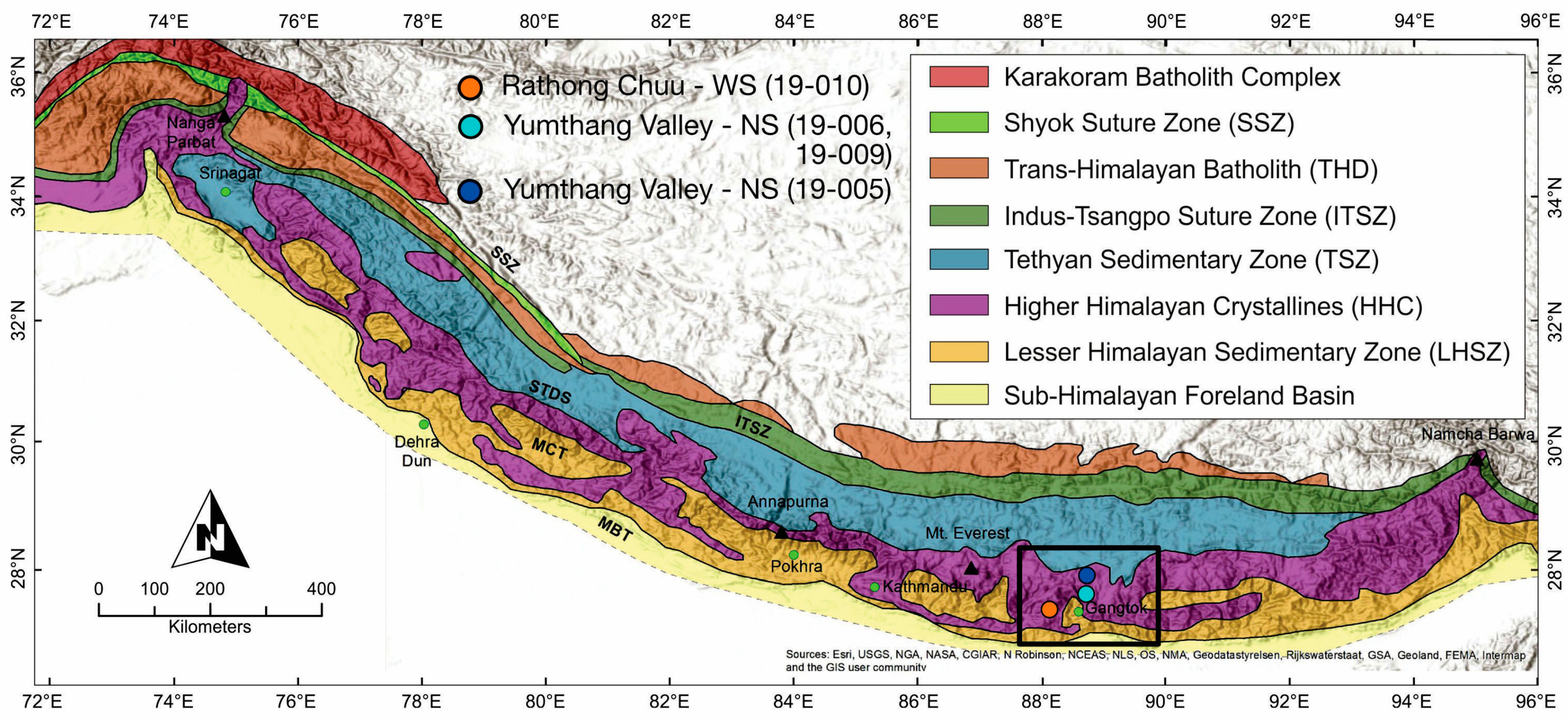
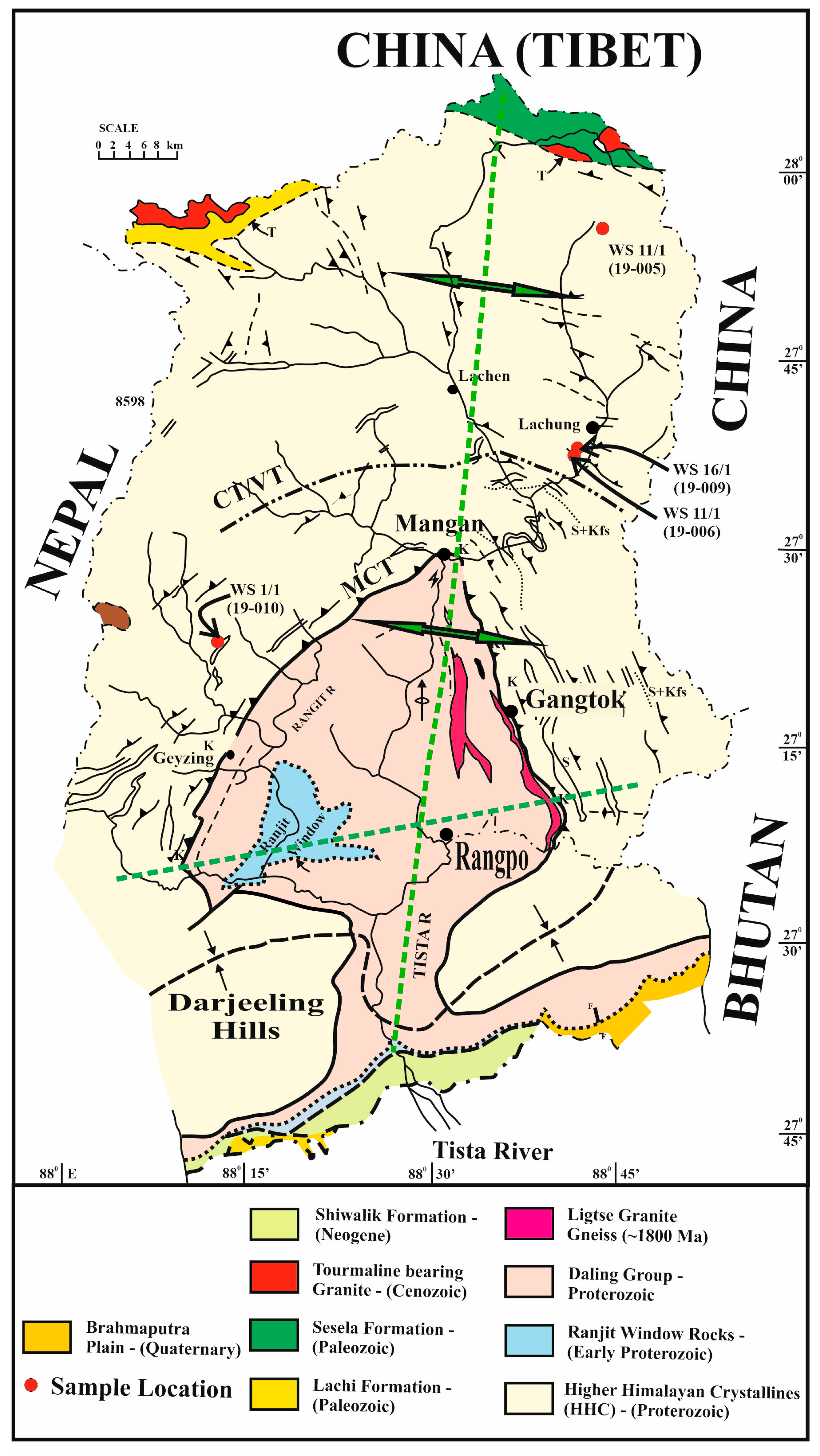
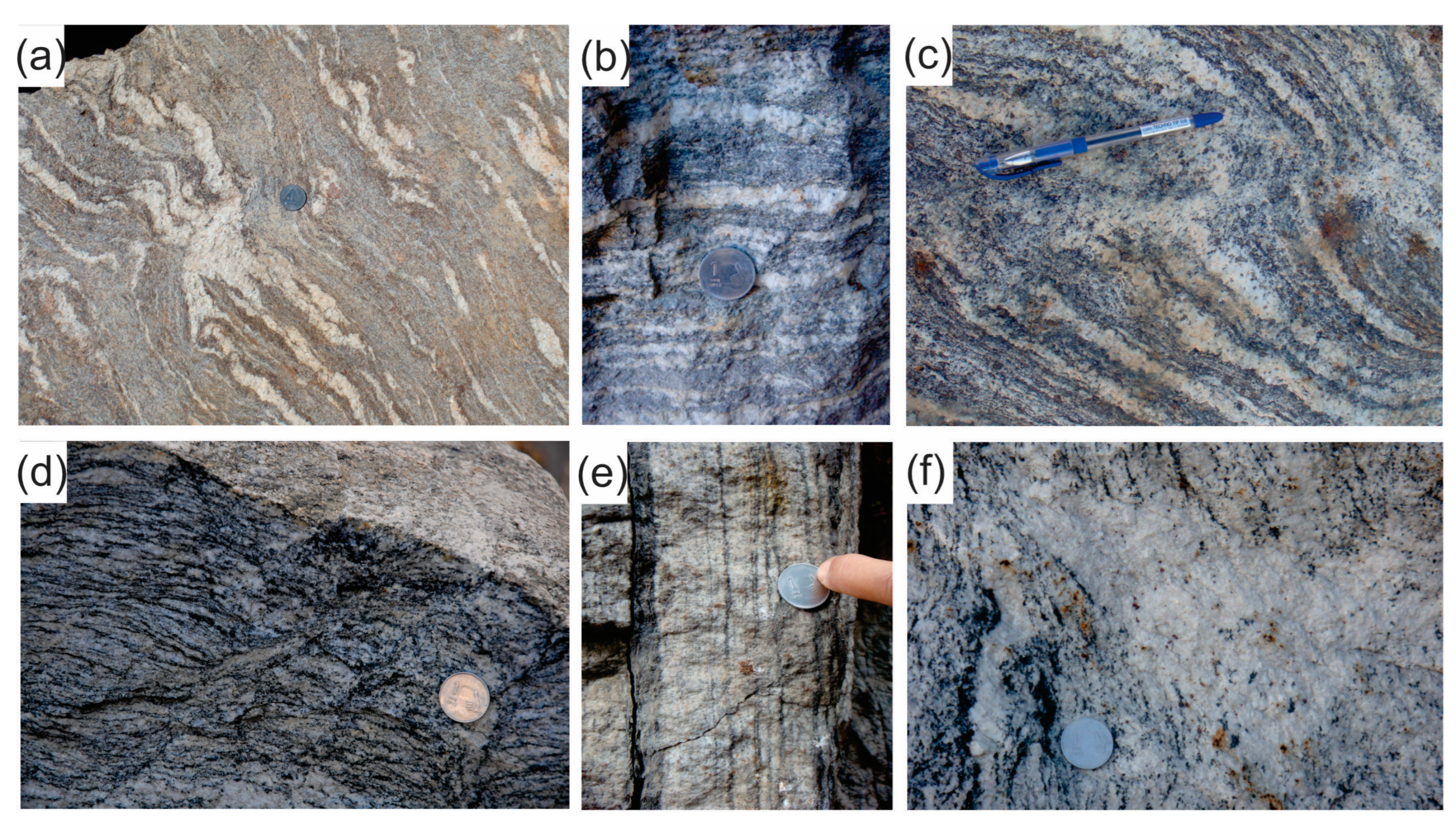
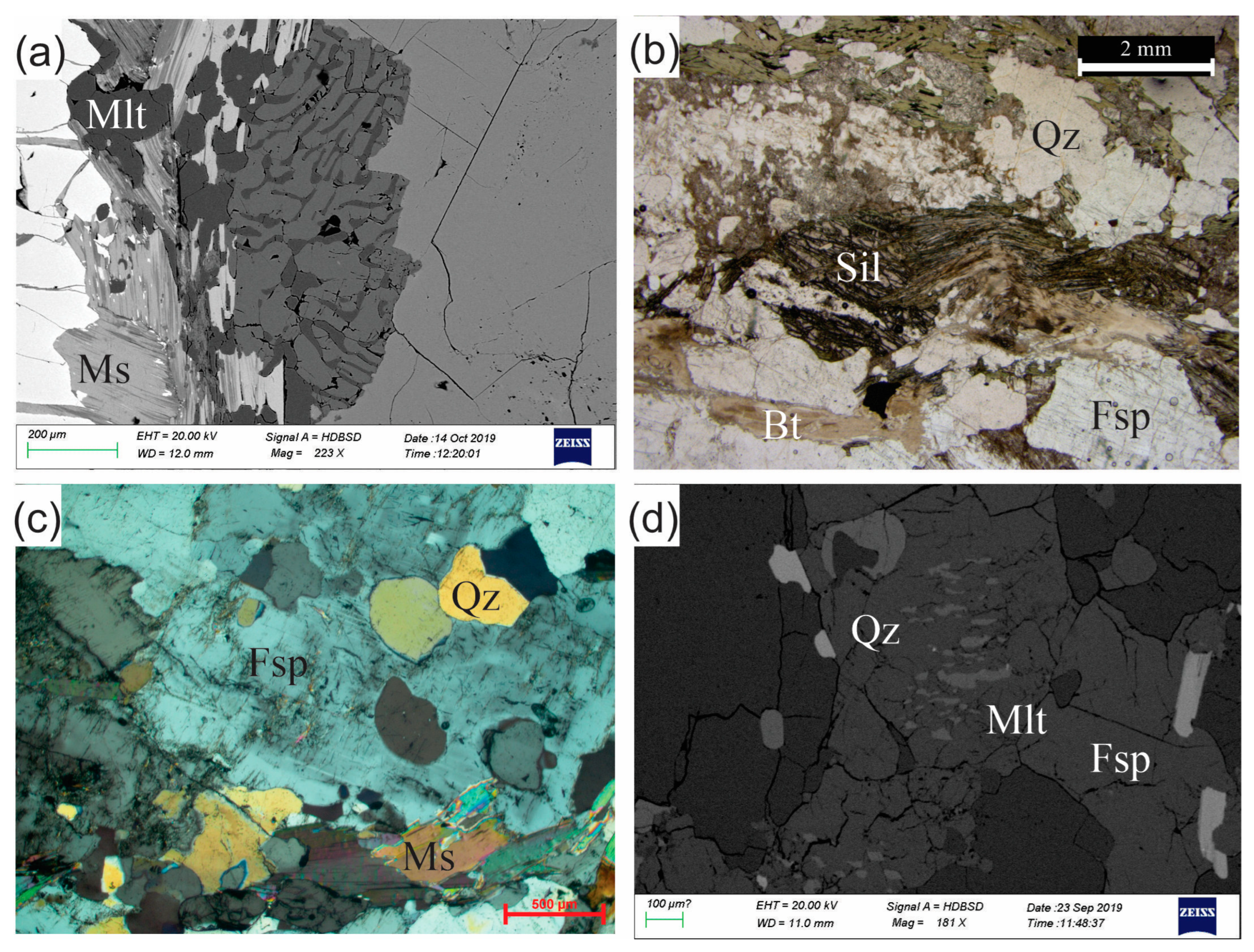
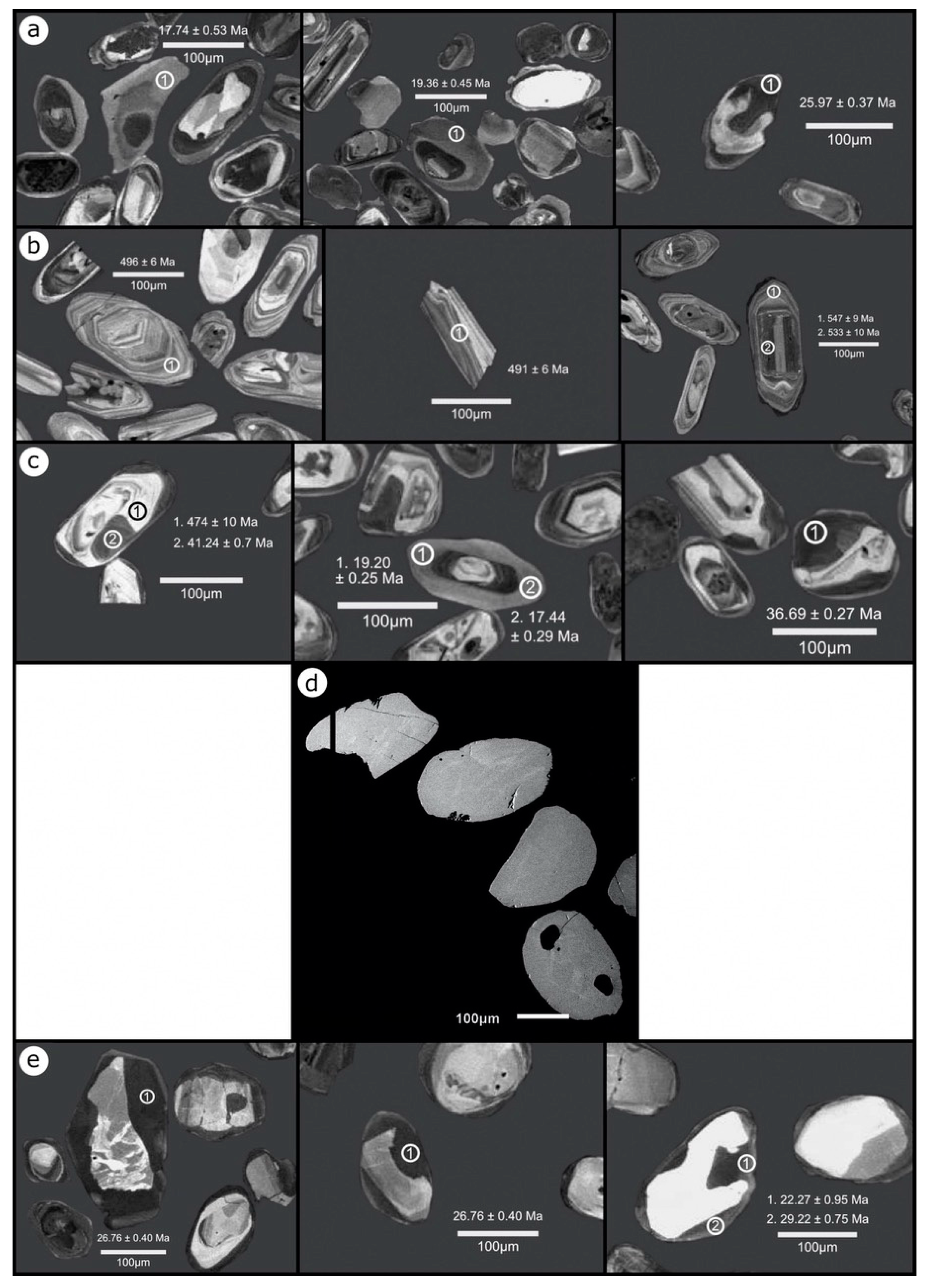
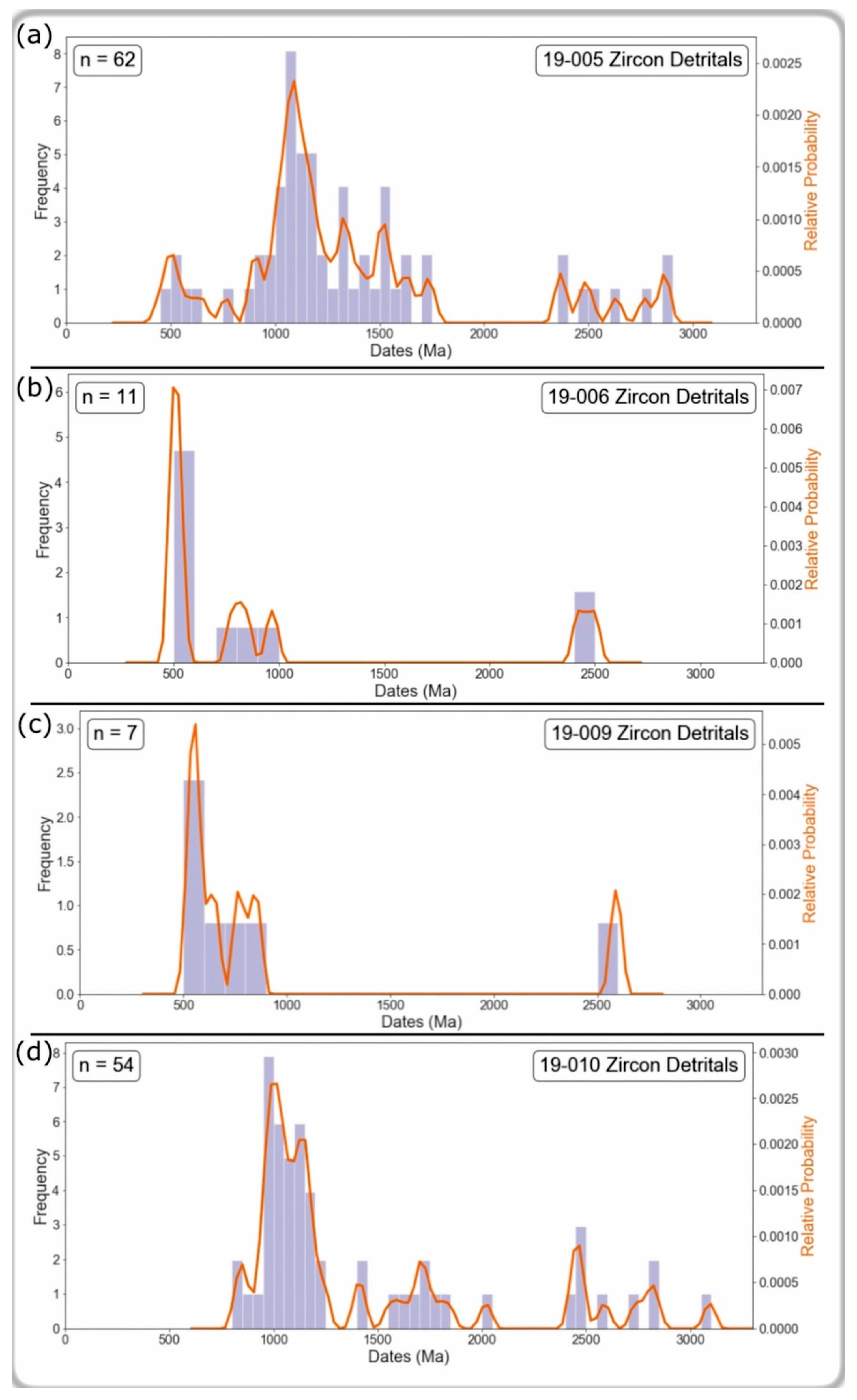
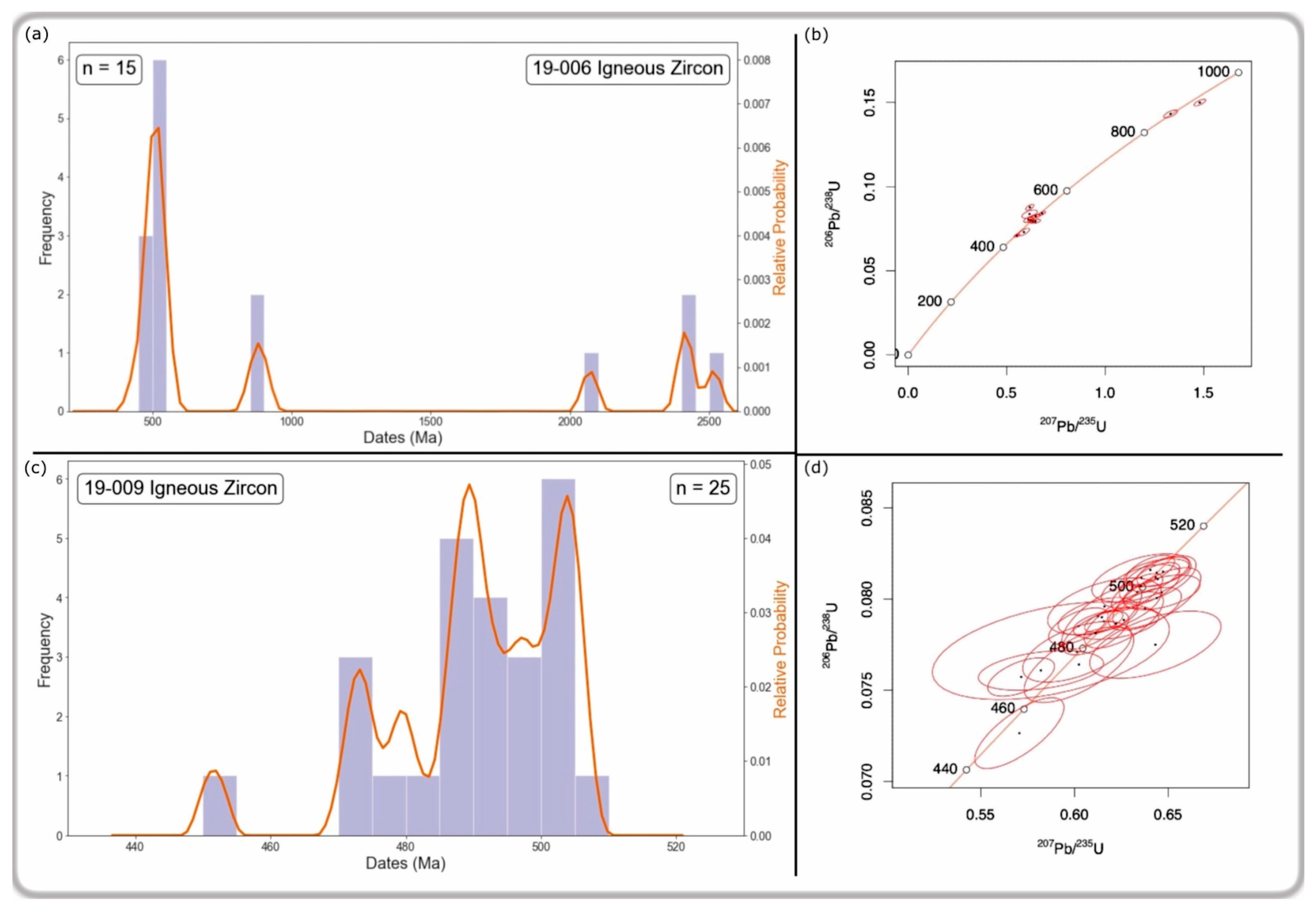
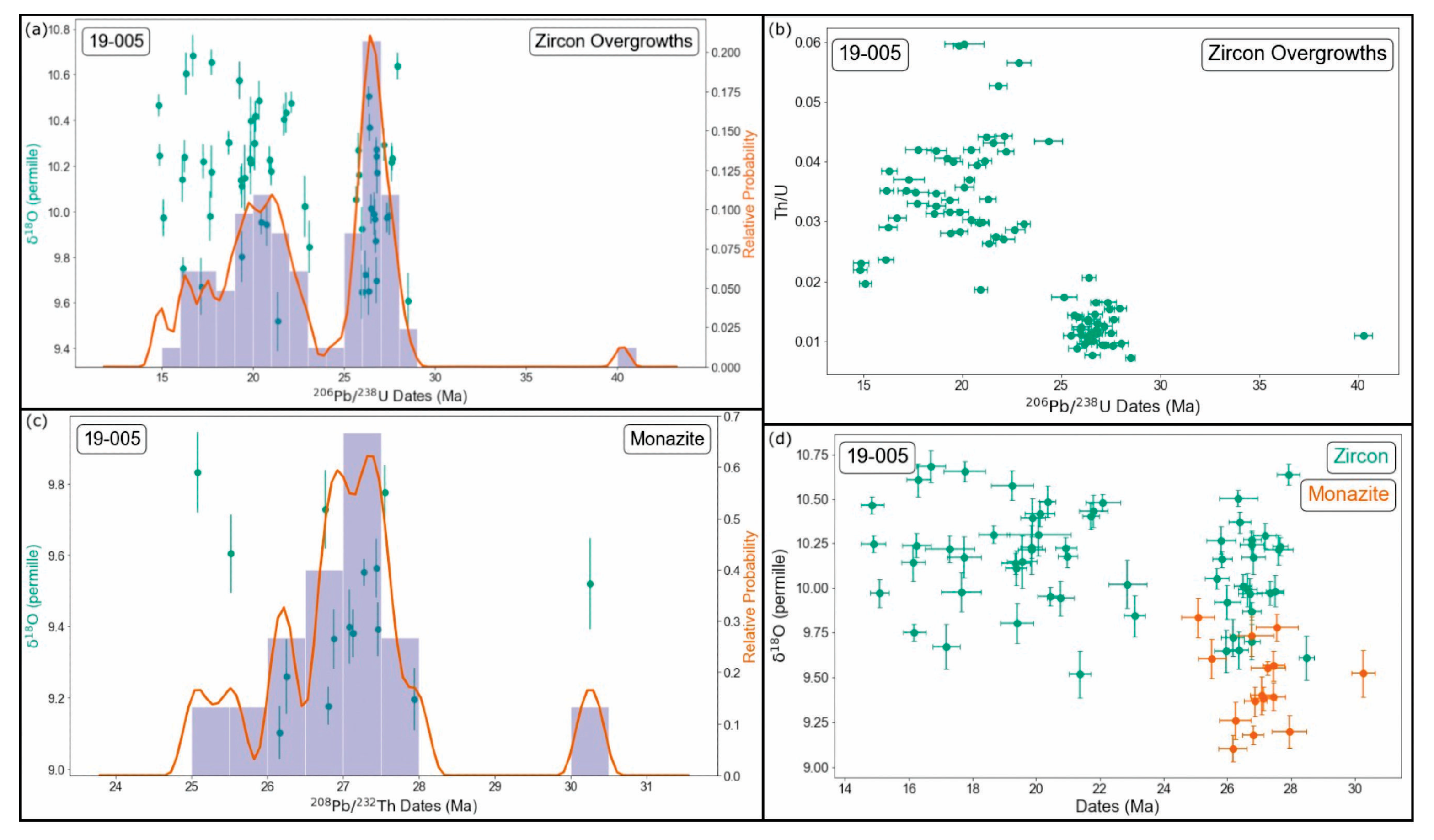

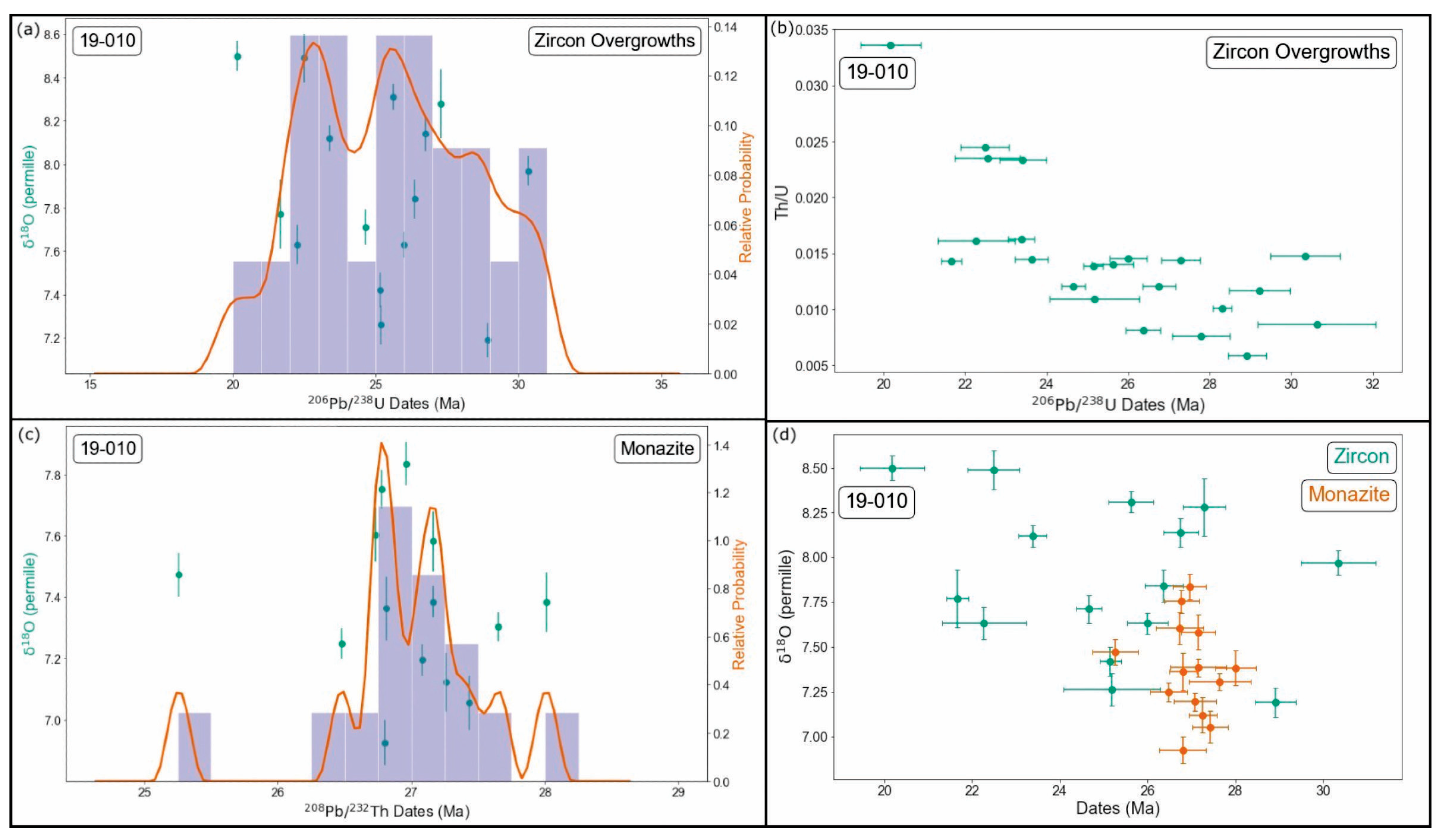
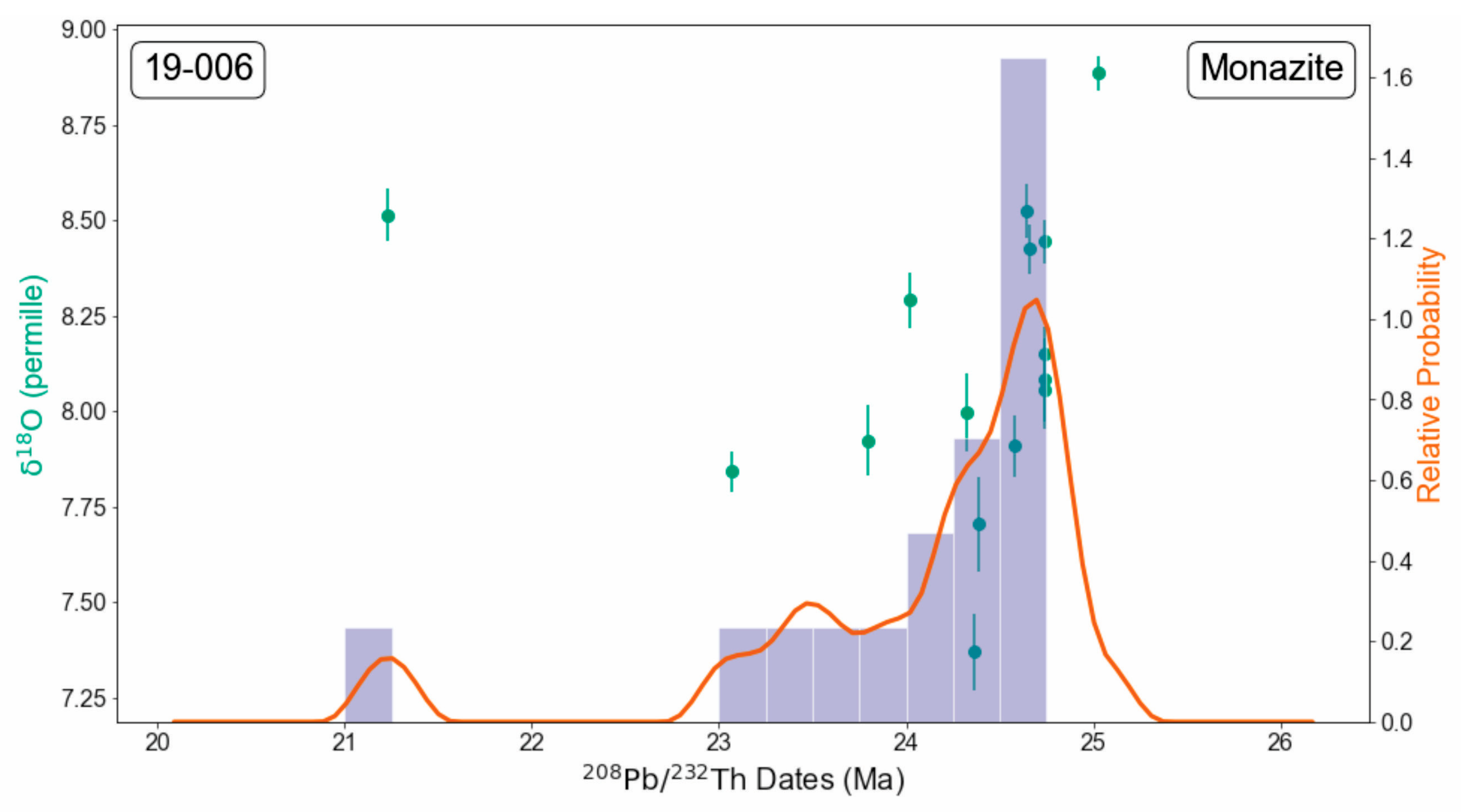

| Location | Sample Number | Age | References |
|---|---|---|---|
| North Sikkim | |||
| Above Chungthang Thrust (Zircon ages) | CLN-8 | 31.4 Ma, 24.5 Ma | [34] |
| LNT | 20.5 Ma, 19.0 Ma, 18.5 Ma | [34] | |
| TG8 | 19.9 Ma, 18.2 Ma | [34] | |
| TG9 | 21.1 Ma, 22.0 Ma, 19.9 Ma | [34] | |
| Above Chungthang Thrust (Monazite ages) | CLN-8 (migmatite metapelites) | 22.7 ± 0.3 Ma | [31] |
| 21.9 ± 1.1 Ma | [31] | ||
| 31.4 Ma | [34] | ||
| CLN-6 | 29.0 Ma, 25.3 Ma, 27.7 Ma, 23.8 Ma | [34] | |
| CLN-5 | 28.0 Ma,26.8 Ma, 28.8 Ma, 25.6 Ma | [34] | |
| LNT-2 | 23.3–20.9 Ma, 23.5–20.7 Ma | [34] | |
| LNT-5 | 36.9–24.0–19.2 Ma 36.9–21.0 Ma, 36.4–35.6 Ma | [34] | |
| TG-9 (migmatite and metapelite) | 24.5–22.5 Ma, 23.5–20.2 Ma | [34] | |
| TG-9 (Leucosome) | 23.5–20.7 Ma, 24.5-22.5 Ma, 23.5–20.2 Ma, 21.4–16.9 Ma, 23.0–16.5 Ma | [34] | |
| TG-8 (migmatite metapelite) | 25.5-20.6 Ma, 26.2 Ma | [34] | |
| Below Chungthang Thrust (Monazite ages) | 13.8 ± 1.0 Ma | [31] | |
| Below MCT (Monazite ages) | 13.0 ± 0.2 Ma 12.3 ± 0.6 Ma | [31] | |
| Eastern Sikkim | |||
| Above Chungthang Thrust (Monazite ages) | 141 | 22.0 ± 0.3 Ma | [31] |
| 24.0–18.9 Ma, 26.7–21.2 Ma, | [34] | ||
| 26.5–18.8 Ma 22.7 ± 0.3 Ma 21.9 ± 1.1 Ma | [35] | ||
| Below Chungthang Thrust (Monazite ages) | 13.0 ± 0.4 Ma 12.7 ± 0.1 Ma | [31] | |
| 15.9 ± 1.0 Ma | [35] | ||
| Around MCT (Monazite ages) | ~21–12 Ma (Core and Rim of Gt) ~21–16 Ma (Core and Rim of Gt) 12.8 ± 0.2 Ma (in Staurolite) 11.8 ± 0.2 Ma Matrix | [35] | |
| Western Sikkim | |||
| Sm-Nd Gt from leucosome | 16.1 ± 2.4 Ma RIM 23.0 ± 2.8 Ma CORE | [32] | |
Disclaimer/Publisher’s Note: The statements, opinions and data contained in all publications are solely those of the individual author(s) and contributor(s) and not of MDPI and/or the editor(s). MDPI and/or the editor(s) disclaim responsibility for any injury to people or property resulting from any ideas, methods, instructions or products referred to in the content. |
© 2024 by the authors. Licensee MDPI, Basel, Switzerland. This article is an open access article distributed under the terms and conditions of the Creative Commons Attribution (CC BY) license (https://creativecommons.org/licenses/by/4.0/).
Share and Cite
Prabha-Mohan, S.; Williams, I.S.; Singh, S. Zircon, Monazite SHRIMP U-Th-Pb and Quartz Oxygen Isotopic Results from the Higher Himalayan Crystallines (HHC) of the Sikkim Himalayas. Minerals 2024, 14, 572. https://doi.org/10.3390/min14060572
Prabha-Mohan S, Williams IS, Singh S. Zircon, Monazite SHRIMP U-Th-Pb and Quartz Oxygen Isotopic Results from the Higher Himalayan Crystallines (HHC) of the Sikkim Himalayas. Minerals. 2024; 14(6):572. https://doi.org/10.3390/min14060572
Chicago/Turabian StylePrabha-Mohan, Shashank, Ian S. Williams, and Sandeep Singh. 2024. "Zircon, Monazite SHRIMP U-Th-Pb and Quartz Oxygen Isotopic Results from the Higher Himalayan Crystallines (HHC) of the Sikkim Himalayas" Minerals 14, no. 6: 572. https://doi.org/10.3390/min14060572







